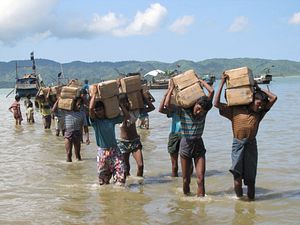Over the past few months, there have been several outbursts of international outrage over the various dimensions of Southeast Asia’s trafficking problem. The region’s ongoing refugee crisis involving the Rohingya, the discovery of mass graves in Malaysia and Thailand, and continuing allegations of slave labor in Thailand’s seafood industry, have once again exposed Southeast Asia’s embarrassing record on this issue.
For seasoned regional observers, none of this is new. The key question has long been whether Southeast Asian governments and other actors can take far bolder efforts to address this problem so that much more progress can be achieved than is currently the case.
Last week, Keith Luse, who served as an aide to former Senator Richard Lugar – the ex-chairman of the Senate Foreign Relations Committee and one of the few U.S. lawmakers with a firm grasp of Asia – spoke about the issue at an event organized by the Center for Strategic and International Studies, a Washington, D.C.-based think tank. Luse knows the field well, having actually participated in a congressional investigation on aspects of human trafficking in the past. In brief remarks which lasted about ten minutes, he touched on the roles of various actors and what they can do to help address the trafficking problem.
Luse began by acknowledging the ongoing work of various actors on the issue in spite of remaining problems and ongoing challenges. Malaysia, for instance, has worked with the United Nations High Commissioner for Refugees (UNHCR) since 1975 to varying degrees including on the resettlement of hundreds of thousands of Vietnamese boat people, in spite of its official refusal to recognize refugees and ongoing rights concerns. Thailand, for its part, has served as a safe haven for refugees from neighboring Southeast Asian countries for decades. However, it is worth recalling the two still sit in the bottom tier of the U.S. State Department’s annual Trafficking in Persons Report – the only two countries in Southeast Asia in this position.
Luse then framed the issue of human trafficking in Southeast Asia as being emblematic of a larger reality, where individuals – migrants, refugees and others – are bought, sold, traded or otherwise mistreated. Luse described human trafficking in Southeast Asia as an “economic whirlwind of substantial force” caused by partly by the juxtaposition of extreme poverty with new opportunities for economic exploitation opened by globalization. It is also facilitated by corruption, disregard by many local businesses as to the background and documentation of their employees, and the power wielded by criminal syndicate leaders and masterminds who appear to have gone untouched.
For Luse, if Southeast Asia is to get serious about tackling its trafficking problem, it would need to address all the key aspects of the problem. For starters, Southeast Asian governments, Luse said, must get serious about combating corruption. That means not only limiting themselves to sporadic arrests, convictions, press releases and pronouncements, but consistently and aggressively pursuing the prosecution of the kingpins of trafficking (See: “Thailand’s Mass Graves: A Turning Point?”).
“At the end of the day, the big fish are rarely caught,” he said.
Governments in the region should also work more with non-governmental organizations (NGOs) and civil society groups rather than viewing them as part of the problem.
“Is it possible for Southeast Asian nations, including Malaysia and Thailand, to improve their view of civil society as being part of the solution, rather than part of the problem?” Luse asked rhetorically.
Luse also urged individual leaders from Southeast Asia and the Pacific to think about whether their decisions – including turning away boatloads of children, women and men from their shores – could actually contribute to abetting the trafficking problem instead of helping to mitigate it.
Turning to the role of the Association of Southeast Asian Nations (ASEAN), Luse cautioned that the trafficking problem could worsen as ASEAN moves toward greater economic integration unless leaders come up with a comprehensive strategy to collectively address it (See: “A Surge in Southeast Asian Transnational Crime?”).
“Inaction by ASEAN will contribute to regional instability,” Luse warned.
Aside from that, Luse said the private sector – both in the region as well as globally – also has a role to play. Foreign investors, he said, should demand accountability and ensure that their workforce and that of their subcontractors do not include trafficking victims, thereby setting an example for companies within ASEAN. Companies should also take steps to ensure that slave labor is not part of the supply chain. The California Transparency and Supply Chains Act and the UK Modern Slavery Act of 2015, Luse said, are examples of what future legislation might look like in this regard.
Of course, no brief exploration of Southeast Asia’s human trafficking dilemma can do the subject justice. But Luse’s remarks do illustrate the complexity of the issue and the difficulty in getting various actors to work together to make progress on one of the region’s most vexing problems.
































